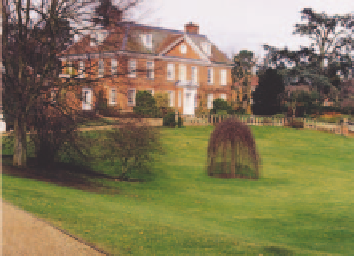Agriculture Reference
In-Depth Information
Figure 60
Prints of
c
.1800, showing Aspley House, Aspley Guise (Bedfordshire), 1692, clearly
depicting the lowering of the ground to excavate the brickearth, alongside a modern
photograph of the house and the now gracefully landscaped frontage.
Figure 61
The huge numbers of bricks that were required for this property and the use
of the on-site brickearth strongly suggest clamp rather than kiln-burnt bricks.
It was clear that the best of these Aspley House bricks in terms of regularity
of shape, consistency of texture and colour were selected, after firing, for use
as rubbers for the gauged enrichments (such as flat arches and Platt band).
Cutting and rubbing a number of these original face bricks during preparation
for the above testing showed them to behave (300 years on) like the very best
of rubbing bricks; clean-bodied with occasional small inclusions. These pre-
sented no difficulties and were very common in most rubbers up to the mid-
nineteenth century.
As Prentice (1996, 1-2) states:
The house is situated on the outcrop of Lower Greensand (Cretaceous Age). This
predominantly is a sand formation, and at first sights not thought of as suitable
for the production of bricks. However, the lower stratigraphic level of this forma-
tion, on which 'Aspley House' is sited contain much argillaceous material, and
could be used to produce a satisfactory, if somewhat weak, building brick.
Winslow Hall in Buckinghamshire (1698-1701) (Fig. 62) was built by
Sir William Lowndes (1652-1724) who, through his official position as the
Chancellor of the Exchequer, was in professional communication with Sir
Christopher Wren. Wren closely examined the accounts for the construction
of Winslow Hall for the owner, records of which appear in The Wren Society
(Bolton and Hendry, 1940, Volume XVII, 54).
The property, constructed in the Anglo-Dutch style, has gauged brick
enrichments for the arches, reveals to the openings, piers in the front gar-
den, and a vaulted basement. The master bricklayer was John Yeomans [or
Yemens] (Colvin, 1995, 1134). Transactions for the bricks made for Winslow
Hall are given as follows (Bolton and Hendry, 1940, Volume XVII, 54).


